| Listing 1 - 10 of 34 | << page >> |
Sort by
|
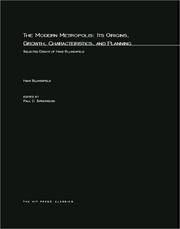
ISBN: 0262520281 026202022X Year: 1972 Publisher: Cambridge (Mass.): MIT press
Abstract | Keywords | Export | Availability | Bookmark
 Loading...
Loading...Choose an application
- Reference Manager
- EndNote
- RefWorks (Direct export to RefWorks)
711.432 --- City planning --- Cities and towns --- Civic planning --- Land use, Urban --- Model cities --- Redevelopment, Urban --- Slum clearance --- Town planning --- Urban design --- Urban development --- Urban planning --- Land use --- Planning --- Art, Municipal --- Civic improvement --- Regional planning --- Urban policy --- Urban renewal --- 711.432 Planologie: hoofdsteden wereldsteden metropolen --- Planologie: hoofdsteden wereldsteden metropolen --- Government policy --- Management --- 711.432 Planologie: hoofdsteden; wereldsteden; metropolen --- Planologie: hoofdsteden; wereldsteden; metropolen --- City planning.
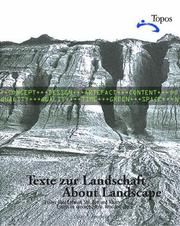
ISBN: 3766715585 Year: 2003 Publisher: München Callwey
Abstract | Keywords | Export | Availability | Bookmark
 Loading...
Loading...Choose an application
- Reference Manager
- EndNote
- RefWorks (Direct export to RefWorks)
711.432 --- 712.03 --- 719 --- 711.4 --- 711.4 Gemeentelijke planologie. Stadsplanning. Stedenbouw --- Gemeentelijke planologie. Stadsplanning. Stedenbouw --- 719 Natuurbescherming. Landschapsbescherming. Heemschut --- Natuurbescherming. Landschapsbescherming. Heemschut --- 712.03 Stijlen en scholen in de landschapsarchitectuur --- Stijlen en scholen in de landschapsarchitectuur --- 711.432 Planologie: hoofdsteden wereldsteden metropolen --- Planologie: hoofdsteden wereldsteden metropolen --- 711.432 Planologie: hoofdsteden; wereldsteden; metropolen --- Planologie: hoofdsteden; wereldsteden; metropolen
Book
ISBN: 9789064507410 Year: 2010 Publisher: Rotterdam 010
Abstract | Keywords | Export | Availability | Bookmark
 Loading...
Loading...Choose an application
- Reference Manager
- EndNote
- RefWorks (Direct export to RefWorks)
Urbanization has evolved dramatically from monocentric settlements to polycentric networks and megacities of previously inconceivable size and population. This escalation of quantities and scales has ignited a deep and growing fascination for the phenomenon of megacities. The book’s point of departure is to define megacities and understand their processes and systems of organization. From this discussion it aims to glean lessons for researchers, practitioners, politicians and the general public. The Megacities Foundation, which initiated this discussion and book, has set a benchmark in the architectural profession, and has actively encouraged debate on megacities for the last fifteen years by inviting leading international academics and practitioners from the fields of architecture, economics, geography, sociology and urban planning. This book offers a compilation of the best lectures about the definition, evolution, governance and design guidelines of megacities. In addition, it incorporates reflections on what megacities could mean in the Dutch planning context. Megacities is a body of knowledge for comprehending the essence of urban growth and exploring a sustainable future.
ruimtelijke ordening --- steden --- cities --- Environmental planning --- Economic geography --- comprehensive plans [reports] --- 711.432 --- 911.375.633 --- 711.4 --- Planologie: hoofdsteden; wereldsteden; metropolen --- Stadsrand-gebieden --- Stedenbouw --- Stedenbouw (theorie) --- Grootsteden --- Metropolen --- 711.432 Planologie: hoofdsteden; wereldsteden; metropolen
Book
ISBN: 9788899854737 8899854734 Year: 2018 Publisher: [Trento] LISt Lab
Abstract | Keywords | Export | Availability | Bookmark
 Loading...
Loading...Choose an application
- Reference Manager
- EndNote
- RefWorks (Direct export to RefWorks)
Contemporary large scale interventions, leading ongoing transformation processes of world cities, are often related to mobility systems. Developed around the re-conversion or the implementation of infrastructural nodes, they deeply impact surrounding areas within a more general rethinking of urban conditions. However, the relation between urbanity and infrastructure appears at least ambiguous. On the one hand mobility flows represent key components and engines for transformations, on the other hand their physical presence progressively disappears from the urban scene itself, subtly declaring a figurative irreconcilability between the two. Starting from this observation the book, as a contribution for the architectural and urban discourse, reflects on the status of a conflicting relation, with a specific focus on the 20th century, retracing paradigmatic design positions to outline in which ways these hidden infrastructures are actually reshaping the contemporary city scape and which are the opportunities in the architectural research.
Urbanisme --- Espaces publics --- City planning --- Public spaces --- Histoire. --- History --- Public places --- Social areas --- Urban public spaces --- Urban spaces --- Cities and towns --- 711.432 --- 711.432 Planologie: hoofdsteden; wereldsteden; metropolen --- Planologie: hoofdsteden; wereldsteden; metropolen
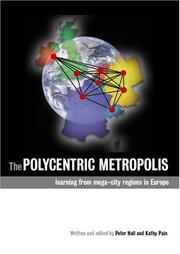
ISBN: 1844073297 9781844073290 9781849773911 9781136547645 9781136547683 9781136547690 9781844077472 1844077470 Year: 2009 Publisher: London Sterling
Abstract | Keywords | Export | Availability | Bookmark
 Loading...
Loading...Choose an application
- Reference Manager
- EndNote
- RefWorks (Direct export to RefWorks)
Metropolitan areas --- 711.2 --- 711.432 --- Regional planning --- City planning --- Regional development --- State planning --- Human settlements --- Land use --- Planning --- Landscape protection --- 711.432 Planologie: hoofdsteden wereldsteden metropolen --- Planologie: hoofdsteden wereldsteden metropolen --- 711.2 Regionale planologie. Streekplannen. B P A , beperkt plan van aanleg --- Regionale planologie. Streekplannen. B P A , beperkt plan van aanleg --- Government policy --- 587 Stedenbeleid --- 711.432 Planologie: hoofdsteden; wereldsteden; metropolen --- Planologie: hoofdsteden; wereldsteden; metropolen --- Environmental planning --- Economic geography --- Europe --- Geografie --- Sociale geografie --- Bewoning en leefgemeenschap. --- Agglomérations urbaines --- Aménagement du territoire --- Urbanisme

ISBN: 2747544443 9782747544443 Year: 2003 Publisher: Paris L'Harmattan
Abstract | Keywords | Export | Availability | Bookmark
 Loading...
Loading...Choose an application
- Reference Manager
- EndNote
- RefWorks (Direct export to RefWorks)
Sociology, Urban --- Sociologie urbaine --- Urbanization --- 316.334.56 --- 711.432 --- 911.3:32 --- Stadssociologie--(algemeen) --- Planologie: hoofdsteden; wereldsteden; metropolen --- Geopolitiek. Politieke geografie --- 911.3:32 Geopolitiek. Politieke geografie --- 711.432 Planologie: hoofdsteden; wereldsteden; metropolen --- 316.334.56 Stadssociologie--(algemeen) --- Sociology, Urban - Congresses --- Urbanization - Congresses.
Book
ISBN: 9780714859569 0714859567 Year: 2010 Publisher: London Phaidon
Abstract | Keywords | Export | Availability | Bookmark
 Loading...
Loading...Choose an application
- Reference Manager
- EndNote
- RefWorks (Direct export to RefWorks)
Urbanization. --- Urban policy. --- City planning. --- Globalization. --- Cities and towns --- Urbanisation --- Politique urbaine --- Urbanisme --- Mondialisation --- Villes --- Growth --- Croissance --- 711.4 --- 316.334.56 --- 711.432 --- 911.375 --- 711.432 Planologie: hoofdsteden; wereldsteden; metropolen --- Planologie: hoofdsteden; wereldsteden; metropolen --- 711.4 Gemeentelijke planologie. Stadsplanning. Stedenbouw --- Gemeentelijke planologie. Stadsplanning. Stedenbouw --- 316.334.56 Stadssociologie--(algemeen) --- Stadssociologie--(algemeen) --- Steden. Studie van stedelijke vestiging. Geografie van steden. Stadsgeografie
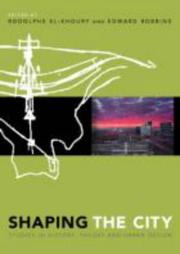
ISBN: 0415261880 0415261899 Year: 2004 Publisher: New York (N.Y.): Routledge
Abstract | Keywords | Export | Availability | Bookmark
 Loading...
Loading...Choose an application
- Reference Manager
- EndNote
- RefWorks (Direct export to RefWorks)
This unique text looks at the history of the city by focusing on a series of critical issues in urban design that are exemplified by cities like Paris, London, New York, Berlin, Vienna and Chicago at particular times in the 19th and 20th centuries. Each author provides a case study highlightning partiular issues of design characteristic to that city. Eleven cities are examined and chapters on the asian city, the new urbanism, the cybercity and utopia are also included. The panel of authors, each an acknowledged specialist in their chosen city, have provided a unique critique that will attract the attention of anyone with an interest in cultural geography and urban anthropology as well as students of architecture, urban design and planning.
Cities and towns --- City planning --- Metropolitan areas --- Sociology, Urban. --- History --- Planologie: hoofdsteden; wereldsteden; metropolen --- 711.432 Planologie: hoofdsteden; wereldsteden; metropolen --- Sociology, Urban --- 316.334.56 --- 711.432 --- 711.4 --- 711.4 Gemeentelijke planologie. Stadsplanning. Stedenbouw --- Gemeentelijke planologie. Stadsplanning. Stedenbouw --- 316.334.56 Stadssociologie--(algemeen) --- Stadssociologie--(algemeen) --- Urban sociology --- Conurbations --- MAs (Metropolitan areas) --- Metropolitan statistical areas --- Urban areas --- Global cities --- Municipalities --- Towns --- Urban systems --- Human settlements --- Urbanisme --- Agglomérations urbaines --- Villes --- Sociologie urbaine --- Case studies. --- Cas, Etudes de --- Histoire --- Etudes de cas
Book
ISBN: 2916183000 9782916183008 Year: 2005 Volume: 45 (supplément) Publisher: Paris Cité de l'architecture et du patrimoine / IFA
Abstract | Keywords | Export | Availability | Bookmark
 Loading...
Loading...Choose an application
- Reference Manager
- EndNote
- RefWorks (Direct export to RefWorks)
Ce sont sans doute ses contradictions qui rendent fascinante Los Angeles, l'anti-ville qui est pourtant la deuxième ville des États-Unis. Il n'est que de voir la pléiade d'auteurs qui en ont fait la toile de fond de leur roman ou de leur film. Ses défauts majeurs - le paroxysme de l'étalement urbain, une ville-banlieue impraticable sans voiture - portent paradoxalement une part statistique de rêve : celui de la maison individuelle ; celui aussi des strass et paillettes de l'univers hollywoodien...Quand on évoque le paysage de Los Angeles, une plaine côtière entre mer et montagnes (jusqu'à plus de 3000 m), gigantesque oasis suburbaine dans le désert californien, surgissent de multiples clichés : le soleil sur l'océan Pacifique et les grandes plages de sable fin où s'ébrouent les pulpeuses coast-guards en maillot rouge des séries américaines ; les autoroutes urbaines avec leurs échangeurs qui sillonnent les quelque 100 km d'étendue de l'agglomération ; les nappes de lotissements pavillonnaires noyés dans une végétation plus ou moins dense s'étendant à l'infini au fil de tracés viaires en damiers ; l'émergence des tours de Downtown qui, à l'échelle métropolitaine, a plutôt valeur de monument que de centre-ville, ou celle de plusieurs vagues de collines entre montagne et mer.Autre paradoxe, si l'on s'intéresse plus spécialement à l'architecture : Los Angeles est à la fois un océan de banalité - celle de l'habitation ordinaire, des centres commerciaux standards et des stations-service - et un musée d'architecture de plein air où plusieurs générations de grands architectes modernes et contemporains ont laissé leur signature, notamment pour des maisons particulières, comme Frank Lloyd Wright, Rudolf Schindler et Richard Neutra, puis Charles Eames, Pierre Koenig, John Lautner, Craig Ellwood et Cesar Pelli, ou plus récemment Charles Moore, Frank Gehry, ou Morphosis.. Extrait du site http://www.archi.fr/IFA-CHAILLOT/index.php?g=571 (11/1/06)
Architecture --- City planning --- Guide d'architecture --- Histoire des villes --- Los angeles --- patrimonium --- Los Angeles (Calif.) --- 711.432 --- California --- Planologie: hoofdsteden; wereldsteden; metropolen --- Ruimtelijke ordening (geschiedenis) --- 711.432 Planologie: hoofdsteden; wereldsteden; metropolen --- 71.03 --- 711.4 --- 72.03 --- 72.036 --- Los Angeles --- Stedenbouw (geschiedenis) --- Stedenbouw --- Architectuurgeschiedenis --- Architectuur (geschiedenis) --- Twintigste eeuw (architectuur) --- 20ste eeuw (architectuur) --- architectuur --- ruimtelijke ordening --- Urbanisme --- Buildings, structures, etc. --- History. --- Constructions --- Histoire --- Los Angeles [California] --- Architecture - California - Los Angeles. --- City planning - California - Los Angeles.
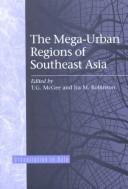
ISBN: 0774805307 077480548X 9780774805483 Year: 1995 Publisher: Vancouver UBC press
Abstract | Keywords | Export | Availability | Bookmark
 Loading...
Loading...Choose an application
- Reference Manager
- EndNote
- RefWorks (Direct export to RefWorks)
711.4 <5> --- 711.432 --- Urbanization --- Metropolitan areas --- Regional planning --- Regional development --- State planning --- Human settlements --- Land use --- Planning --- City planning --- Landscape protection --- Conurbations --- MAs (Metropolitan areas) --- Metropolitan statistical areas --- Urban areas --- 711.432 Planologie: hoofdsteden; wereldsteden; metropolen --- Planologie: hoofdsteden; wereldsteden; metropolen --- 711.4 <5> Gemeentelijke planologie. Stadsplanning. Stedenbouw--Azië --- Gemeentelijke planologie. Stadsplanning. Stedenbouw--Azië --- Government policy --- Urbanisation --- Agglomérations urbaines --- Southeast Asia --- Asie du Sud-Est --- Social conditions. --- Conditions sociales
| Listing 1 - 10 of 34 | << page >> |
Sort by
|

 Search
Search Feedback
Feedback About
About Help
Help News
News